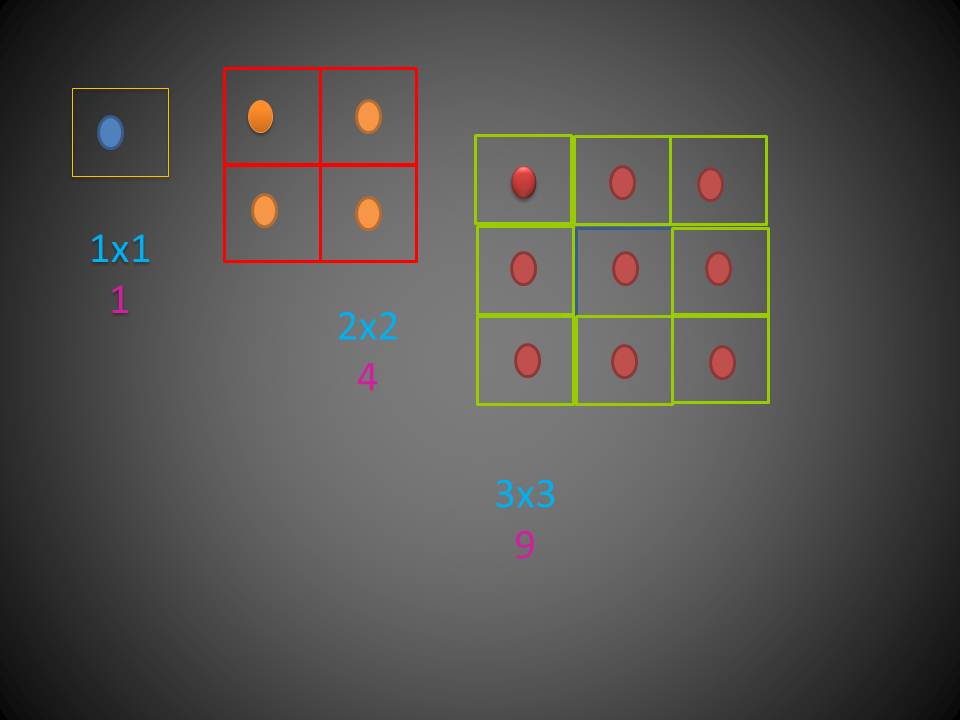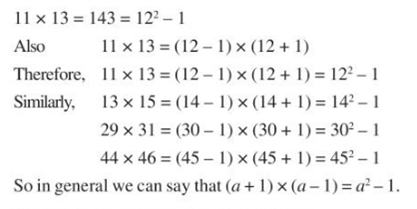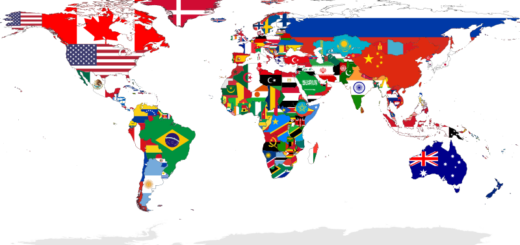Square ,Square Roots
Summary of square and square roots
Solved exercise of square roots

Summary
Square Number
When we multiply the number by itself we will get Square number.A square number is a natural number obtained by multiplying the number it self.
Ex: 6 x 6 =36
5 x 5 = 25
7 x 7 = 49
Area of a Square= side X side
- 1 X 1 = 1
- 2 X 2 = 4
- 3 X 3 = 9
- 4 X 4 = 16
- 5 X 5 = 25
Where 5, 6, 7 are the natural numbers and 25,36,49 are the respective square numbers.
If a natural number m can be expressed as n2 , where n is also a natural number, then m is a Square number.
Any integer multiplied to itself gives Perfect Squares.
Eg: 25,36,49
Non perfect squares: Non perfect squares laying in between perfect squares


Properties of Square Numbers
We can see that the square numbers are ending with 0, 1, 4, 5, 6 or
9 only. None of the square number is ending with 2, 3, 7 or 8.
If a number has 1 or 9 in the units
place, then it’s square ends in 1.
| 1 | 1 |
| 9 | 81 |
| 11 | 121 |
| 19 | 361 |
| 21 | 441 |
Some More Interesting Patterns
Adding Triangular Numbers
If we could arrange the dotted pattern of the numbers in a triangular form then these numbers are called Triangular Numbers.
Eg: 1, 3, 6, 10…………

If we add two consecutive triangular numbers then we can get the square number.

2. Numbers between Square Numbers
If we take two consecutive numbers n and n + 1, then there will be (2n) non-perfect square numbers between their squares numbers.
Example
Let’s take n = 5 and 52 = 25
n + 1 = 5 + 1 = 6 and 62 = 36
2n = 2(5) = 10

Adding Odd Numbers
Sum of first n natural odd numbers is n2.
Any square number must be the sum of consecutive odd numbers starting from 1.
And if any natural number which is not a sum of successive odd natural numbers starting with 1, then it will not be a perfect square.

4. A Sum of Consecutive Natural Numbers
Every square number is the summation of two consecutive positive natural numbers.
If we are finding the square of n the to find the two consecutive natural numbers we can use the formula.

5. The Product of Two Consecutive Even or Odd Natural Numbers
If we have two consecutive odd or even numbers (a + 1) and (a -1) then their product will be (a2– 1)

6. Some More Interesting Patterns about Square Numbers

Exercise 5.1
1. What will be the unit digit of the squares of the following numbers?
(i) 81 (ii) 272 (iii) 799 (iv) 3853 (v) 1234 (vi) 20387 (vii) 52698 (viii) 99880 (ix) 12796
(x) 55555
Solution
(i) Unit digit of 812 = 1
(ii) Unit digit of 2722 = 4
(iii) Unit digit of 7992 = 1
(iv) Unit digit of 38532 = 9
v) Unit digit of 12342 = 6
(vi) Unit digit of 263872 = 9
(vii) Unit digit of 526982 = 4
(viii) Unit digit of 998802 = 0
ix) Unit digit of 127962 = 6
(x) Unit digit of 555552 = 5
2. The following numbers are not perfect squares. Give reason.
i) 1057 (ii) 23453 (iii) 7928 (iv) 222222 (v) 64000 (vi) 89722 (vii) 222000 (viii) 505050
(i)1057 ends with 7 at unit place. So it is not a perfect square number.
(ii) 23453 ends with 3 at unit place. So it is not a perfect square number.
(iii) 7928 ends with 8 at unit place. So it is not a perfect square number.
(iv) 222222 ends with 2 at unit place. So it is not a perfect square number.
(v) 64000 ends with 3 zeros. So it cannot a perfect square number.
(vi) 89722 ends with 2 at unit place. So it is not a perfect square number.
(vii) 22000 ends with 3 zeros. So it can not be a perfect square number.
(viii) 505050 ends with 1 zero. So it is not a perfect square number.
3. The squares of which of the following would be odd numbers?
(i) 431 (ii) 2826 (iii) 7779 (iv) 82004
(i)4312 is an odd number.
(ii) 28262 is an even number.
(iii) 77792 is an odd number.
(iv) 820042 is an even number.
4. Observe the following pattern and find the missing digits
112 = 121
1012 = 10201
10012 = 1002001
1000012 = 1…2…1
100000012 = ………
Solution
According to the above pattern, we have
1000012 = 10000200001
100000012 = 100000020000001
5. Observe the following pattern and supply the missing numbers.
112 = 121
1012 = 10201
101012 = 102030201
10101012 = ……….
……….2 = 10203040504030201
Solution
According to the above pattern, we have
10101012 = 1020304030201
1010101012 = 10203040504030201
6. Using the given pattern, find the missing numbers
12 + 22 + 22 = 32
22 + 32 + 62 = 72
32 + 42 + 122 = 132
42 + 52 + ….2 = 212
52 + ….2 + 302 = 312
62 + 72 + …..2 = ……2
Solution
According to the given pattern, we have
42 + 52 + 202 = 212
52 + 62 + 302 = 312
62 + 72 + 422 = 432
7. Without adding, find the sum.
(i) 1 + 3 + 5 + 7 + 9
(ii) 1 + 3 + 5 + 7 + 9 + 11 + 13 + 15 + 17 + 19
(iii) 1 + 3 + 5 + 7 + 9 + 11 + 13 + 15 + 17 + 19 + 21 + 23
Solution:
We know that the sum of n odd numbers = n2
(i)1 + 3 + 5 + 7 + 9 = (5)2 = 25 [∵ n = 5]
(ii) 1 + 3 + 5 + 7 + 9 + 11 + 13 + 15 + 17 + 19 = (10)2 = 100 [∵ n = 10]
(iii) 1 + 3 + 5 + 7 + 9 + 11 + 13 + 15 + 17 + 19 + 21 + 23 = (12)2 = 144 [∵ n = 12]
8. (i) Express 49 as the sum of 7 odd numbers.
(ii) Express 121 as the sum of 11 odd numbers.
Solution:
(i) 49 = 1 + 3 + 5 + 7 + 9 + 11 + 13 (n = 7)
(ii) 121 = 1 + 3 + 5 + 7 + 9 + 11 + 13 + 15 + 17 + 19 + 21 (n = 11)
9. How many numbers lie between squares of the following numbers?
(i) 12 and 13
(ii) 25 and 26
(iii) 99 and 100.
Solution:
i)We know that numbers between n2 and (n + 1)2 = 2n
Numbers between 122 and 132 = (2n) = 2 × 12 = 24
ii) Numbers between 252 and 262 = 2 × 25 = 50 (∵ n = 25)
(iii) Numbers between 992 and 1002 = 2 × 99 = 198 (∵ n = 99)




























